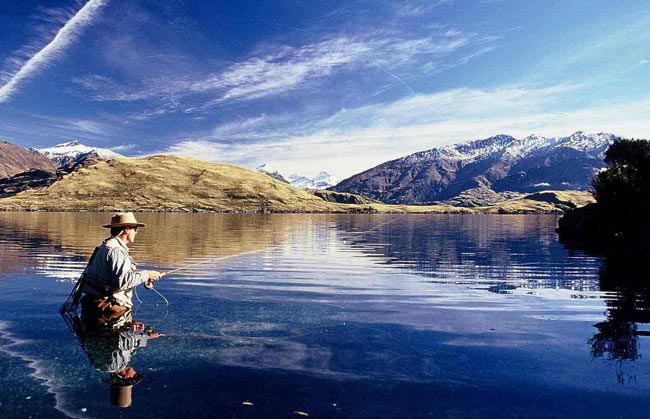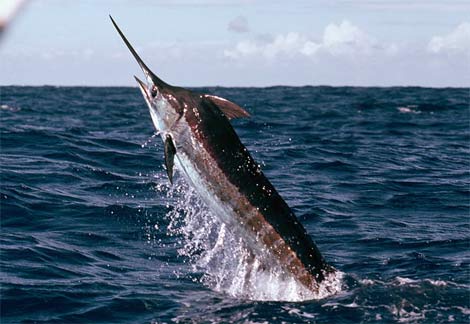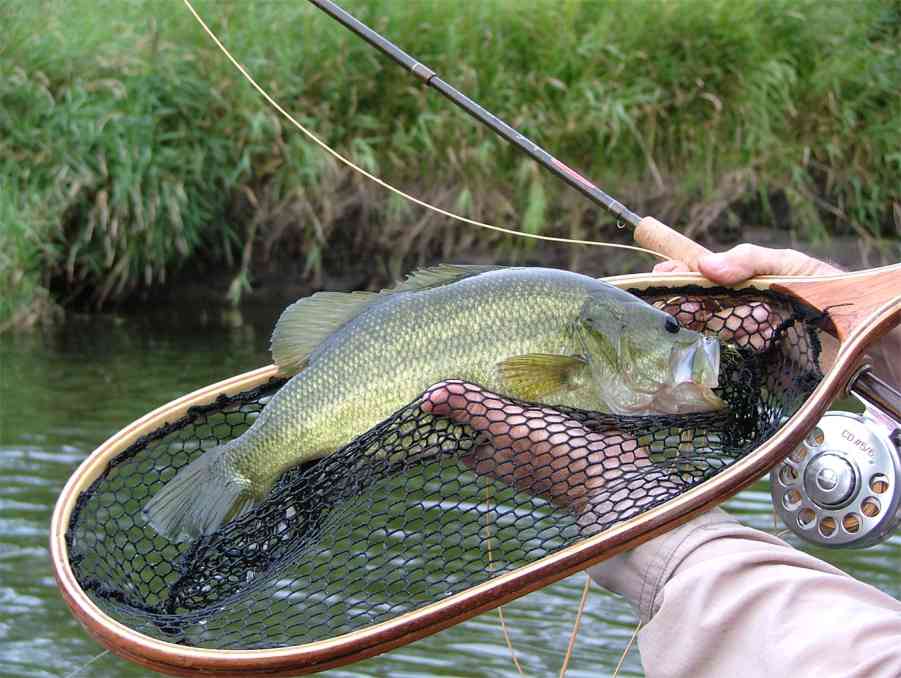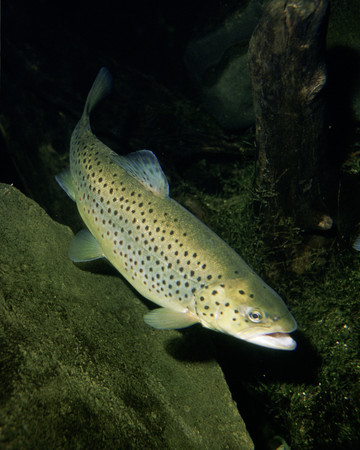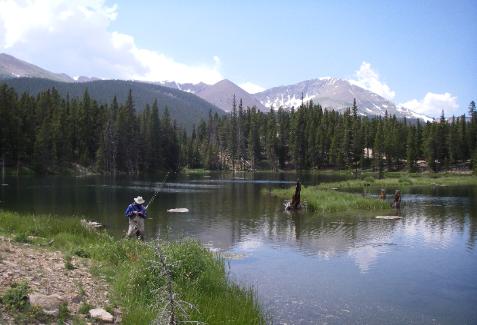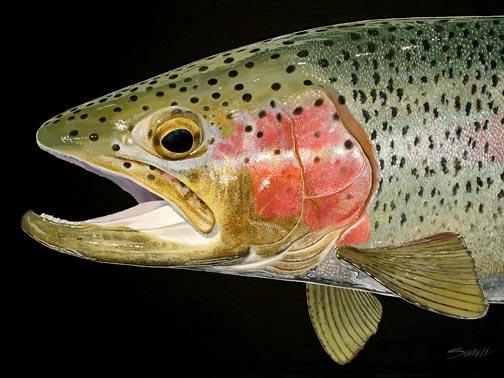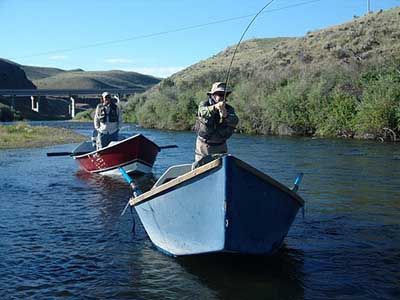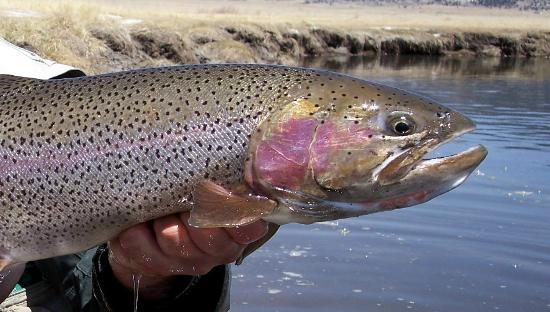|
FLY FISHINGSPORT and ART FORM
Learn to present your fly as accurately as William Tell shot his arrow and you will catch more fish than you have ever dreamed. All it takes is practice, practice, practice.
Then there even might be those who say, "Well, alright, so it's just fishing." But fly fishing, no matter what else it is, is not "just" fishing. It truly is a unique activity and its own one-of-a-kind blend of art and science. Although fly fishing certainly does resemble other types of fishing, and while the end objective is very similar, the devil is in the details. Fly fishing anglers are casting out "flies" to lure the fish. These flies are made from different materials including fur, yarn, shiny things, synthetic parachute-type things, and other stuff. As the name implies, these lures were once upon a time meant to imitate some bug that fish love to eat and would be tempted to bite, at which time the hidden or unnoticed hook would lodge in the fish's mouth and the angler could reel or strip it in.
Now for a bit of history: As a matter of fact, the second and third century AD Roman author and teacher of rhetoric Claudius Aelianus, who was a great naturalist, remarked in one of his writings what he saw crafty Macedonian anglers doing along the Astraeus River. He said these anglers were fastening "wool round a hook, and fit on to the wool two feathers which grow under a cock's wattles, and which in color are like wax. Their rod is six feet long, and their line is the same length. Then they throw their snare, and the fish, attracted and maddened by the color, comes straight at it, thinking from the pretty sight to gain a dainty mouthful; when, however, it opens its jaws, it is caught by the hook, and enjoys a bitter repast, a captive."
That's still largely the motive today, too, but the sport (or art form, take your pick) has evolved so that now there are several techniques and untold different lures that anglers will use while playing at fly angler. To the purists, and they do exist, there can be only one kind of fishing, "dry fly" fishing. The "dry fly" method is so called because the fly is never dunked below the surface of the water. The fly is kept right on the surface, and while it's sometimes lightly dragged by reeling it's typically allowed to just do a "dead float", tempting a fish into believing that a precious piece of protein has died or become unable to fly and is easy prey. The angler, upon seeing the fish bite, lifts his rod up high to set the hook and then begins reeling or stripping in his catch.
"Pure" dry-fly anglers stand knee, hip, or waist-deep in a freshwater source. They want nothing but upstream fishing, and they stalk their fish the way a hunter in the forest stalks a deer or an elk. They use stealth, guile, and cunning and they choose which kind of insect-imitating fly to use by observing what the fish are eating that day(“matching the hatch”), and what's flying or floating about in the area. They need to position themselves to be at once observant, but seemingly just another part of the landscape or an innocent bystander who couldn't care less about fish. However, those who are not purists will also use other techniques: wet-fly, streamer, nymph, emerger, and terrestrial fishing. But all of these still use flies (although those who do streaming are sometimes reluctant to call most of their lures "flies" because they're typically imitating small fish).
But there's more to the things that make fly angling unique than just the flies. The rods and lines are different as well. Fly fishing lines are rated by "weight" according to standards set by AFTMA (the American Fishing Tackle Manufacturers Association). Weight is measured in the total amount of grains that are contained within the first 30 feet of the line, If a fly line is, say, a "5 weight", that would mean that the first 30 feet of line weighs 150 grains (30 grains times 5 grains per foot). A grain is the smallest unit of measure in the U.S.: 1 lb. avoirdupois equals 7000 grains.. The first 30 feet of a 4 weight line will weigh 120 grains; the first 30 feet of a 12 weight line will weigh 360 grains. The most popular weights of fly line range from 4 to 9, and a 12 weight is considered very heavy.
Different kinds of fly fishing lines include "weight forward" and "double taper" (the two most often used) as well as sub-groups like "sinking" and "floating" lines. A fly line is thick--as a matter of fact, too thick to let a fly be tied on to it, so anglers attach a "leader" to the end of their fly line. Leaders are made of a tapering material, allowing them to be threaded through the fly and knotted. The leader, which is practically invisible, allows the fly to move like a tasty insect or other morsel that fish love to eat.
A fly rod gets rated by what amount of a given fly line weight it can efficiently cast out. For instance, a 5 weight fly rod is made to efficiently load 30 feet or more of 5 weight fly line with a 7 to 15 foot leader attached, for a total of up to 45 feet. Modern synthetic composite material rods and pure graphite rods can actually cast farther with efficiency per a given weight.
Tip: For children, I'd go one line weight heavier than the weight of the rod. The heavier line will allow the child to load the rod with greater ease. And speaking of children. you should check out this site: Best Fly Fishing Equipment And Information For Beginners (kids and adults will gain useful information).
The fly fishing angler must carefully take all these things into consideration before he even tries his first cast of the day. Anglers in this sport or art typically have to get through some "false casts" first when they start their fishing day before they make all the right adjustments to the rod, line, and fly that allow them to put something out there that a fish might snap at.
Hopefully, if it wasn't understandable before, it's now clearer why there is such a mystique--and for those experienced, such excitement--surrounding fly fishing. Tip: Please follow all the rules developed by the community in which you are fishing. And please, please use Catch and Release techniques, even if they are not required. You will feel better about yourself and the fish will come back and fight again another day.
Extra Special Tip for all the world's beautiful women fly fishers -- check out this site:
Fly fishing From a Woman’s Perspective For instruction via DVD's, check out the ?How To Fly Fish" DVD series.
Have a Fantastic Fish Story to Tell?Do you have a whopper of a story to tell about the one that got away? How about your most dramatic fish catch ever?
WANT A DISCOUNT COUPON? Just click the " Online Fly Shop" bar and sign up for a free account. You will receive a coupon worth 10% off your next purchase. We take discounting seriously. Return to Fly Fishing Discounters Home Page
|





